
Welcome to the Horn Book's Family Reading blog, a place devoted to offering children's book recommendations and advice about the whats and whens and whos and hows of sharing books in the home. Find us on Twitter @HornBook and on Facebook at Facebook.com/TheHornBook
A New Place You'll Go: Opening Day at The Amazing World of Dr. Seuss Museum
The tagline for the Random House Beginner Book imprint reads “I Can Read It All By Myself” and features a picture of Dr.
 Megan with four of her children. Photo: Sean P. Lambert St. Marie
Megan with four of her children. Photo: Sean P. Lambert St. MarieThe tagline for the Random House Beginner Book imprint reads “I Can Read It All By Myself” and features a picture of Dr. Seuss’s famed Cat in the Hat. A more accurate line to capture the revolutionary impact Theodor Seuss Geisel had on the beginning reader might be “I Can Read It All By Myself — and I Want To!” since his work helped liberate the form from its Not-So-Much-Fun-with-Dick-and-Jane ilk. Fittingly, the child-centered, playful spirit at the heart of Seuss’s beginning readers and picture books is alive and well at the new Amazing World of Dr. Seuss Museum, which opened to the public in his hometown of Springfield, Massachusetts, on June 3, 2017.
The night before the opening, I attended "A Seussian Celebration," a fundraiser gala to mark the opening of the museum. Teachers, librarians, politicians, business leaders, representatives of Dr. Seuss Enterprises, and many Western Massachusetts–based children’s book authors and illustrators were in attendance, too. We feasted on green eggs and ham, roast beast (turkey), and other Seuss-inspired food and drink, and, to paraphrase The Cat in the Hat, we had “lots of good fun that [was] funny.”
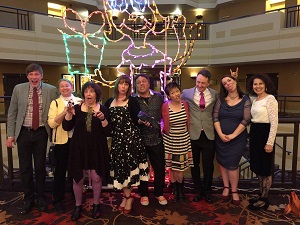 At the opening gala. L-R: Jeff Mack, Diane deGroat, Jane Yolen, Heidi Stemple, Ralph Masiello, Lisa Yee, David Hyde Costello, Megan Dowd Lambert, Lesléa Newman. Photo: Sean P. Lambert St. Marie
At the opening gala. L-R: Jeff Mack, Diane deGroat, Jane Yolen, Heidi Stemple, Ralph Masiello, Lisa Yee, David Hyde Costello, Megan Dowd Lambert, Lesléa Newman. Photo: Sean P. Lambert St. MarieI didn’t manage to get my kids out the door the next morning in time to see the celebratory parade (which fittingly started down the Mulberry Street that Geisel famously referenced in his first children's book), but we caught the tail end of it from our minivan as it crossed into the Quadrangle, the site of the Dr. Seuss National Memorial Sculptural Garden and the Springfield Museums.
“Look at all those Cat-in-the-Hat hats!” my daughter exclaimed, and yes, red-and-white-striped top hats were ubiquitous on the heads of parade participants and spectators, alike. As we entered the Quadrangle we were met with the sight of hundreds of people cheering the ribbon cutting, taking photos with costumed characters, clowns, stilt walkers, and an enormous Cat in the Hat balloon, and lining up for the first round of ticketed entry into the Seuss Museum.
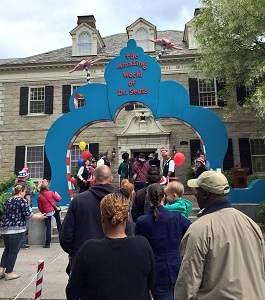 Photo: Megan Dowd Lambert
Photo: Megan Dowd LambertThe rather staid façade of the building in which the museum is housed is dressed up by a Seussian entryway painted in the red, white, and blue hues of The Cat in the Hat, with black-and-white stemmed pink flowers sprouting from its top. Karen Fisk, director of public relations and marketing for the Springfield Museums, told me that they plan to paint the door pink as well, to better connect the outside of the building with its interior. Such a move will only underscore the feeling that one is walking through a portal into a fantasy world. A riot of color meets the eye once inside, with details in decor and displays that are pulled from Geisel’s childhood and his books, and with invitations to play, to explore, and to read, at every turn.
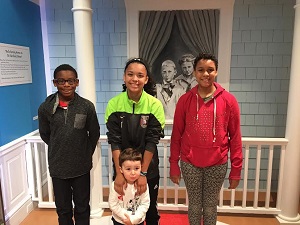 Four of Megan’s children by a display about Geisel’s childhood home. Photo: Megan Dowd Lambert
Four of Megan’s children by a display about Geisel’s childhood home. Photo: Megan Dowd LambertThe first room we entered highlights Geisel's Springfield childhood and acts as a precursor of sorts to the second-floor exhibits, which are dominated by biographical material about his life and career. When I had my kids stop to pose for a picture alongside a photo of the boy Geisel and his sister, my two-year-old was not pleased at being held back even momentarily from the other rooms, which are filled with interactive displays, toys, and books.
“It’s fun to have fun, but you have to know how” opines The Cat, and my kids got right down to having fun in the adjoining first-floor rooms, which invite visitors to draw on a screen (just as young Ted Geisel drew on his bedroom walls), to read Seuss’s books, to build a zoo with Duplo blocks, to engage with early literacy skills activities, and to cavort with models of some of Dr. Seuss’s most beloved characters.
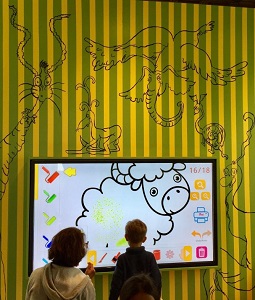 Photo: Megan Dowd Lambert
Photo: Megan Dowd Lambert Photo: Megan Dowd Lambert
Photo: Megan Dowd Lambert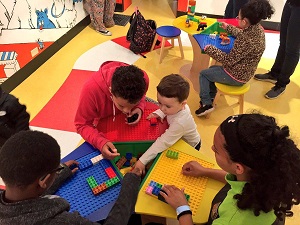 Photo: Megan Dowd Lambert
Photo: Megan Dowd LambertSome spaces were better-developed than others — the Pet Store room, for example, has a television hung in a non-functioning fireplace with a Dr. Seuss book read on a loop, a collection of stuffed animals, and nothing else. The Readingville Room, on the other hand, includes displays of characters and interactive screens that promote phonemic and phonetic awareness. On the whole, there’s an emphasis on verbal literacy and play-based learning on the museum’s first floor, and promise for good things to come.
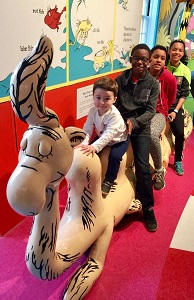 On the Seven Hump Wump in the Readingville Room. Photo: Megan Dowd Lambert
On the Seven Hump Wump in the Readingville Room. Photo: Megan Dowd Lambert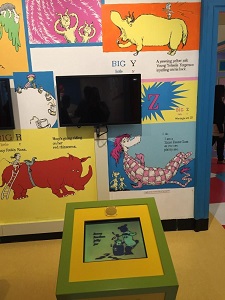 The Readingville room. Photo: Megan Dowd Lambert
The Readingville room. Photo: Megan Dowd Lambert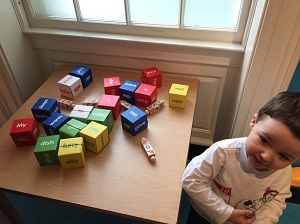 The Readingville room. Photo: Megan Dowd Lambert
The Readingville room. Photo: Megan Dowd Lambert* * * * *
The second floor of the museum feels more like a traditional museum. One room, which visitors can't enter but can observe through a roped-off doorway, is set up as a replica of Geisel’s den, and just outside is his drawing table and chair, his art supplies, and other materials from his artistic career. Another room is devoted to his family life, and another is a treasure trove of ephemera from Geisel’s career, including ample correspondence with family and colleagues. My favorite piece was a rejected drawing given to his stepdaughter Lark Grey Dimond-Cates, with an inscription that reads: “From Ted to Lark to prove to her that everyone makes mistakes.”
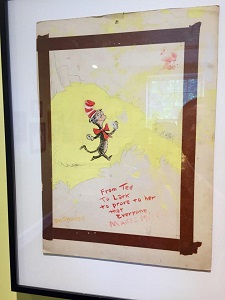 Photo: Megan Dowd Lambert
Photo: Megan Dowd Lambert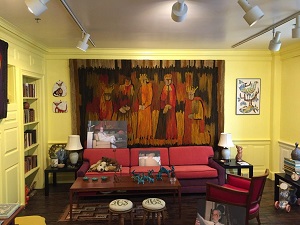 Geiseil’s re-created studio. Photo: Megan Dowd Lambert
Geiseil’s re-created studio. Photo: Megan Dowd LambertDimond-Cates has been instrumental in the founding of the museum and is the artist behind the magnificent Dr. Seuss National Memorial Sculptural Garden outside its doors, which was installed fifteen years ago.
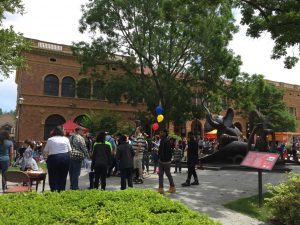 Sculptural Garden. Photo: Megan Dowd Lambert
Sculptural Garden. Photo: Megan Dowd LambertAnother room on the second floor of the museum is devoted to Dimond-Cates’s work. A display of the step-by-step casting the statues demystifies her process, and sketches and models highlight the painstaking work that went into making her vision a reality.
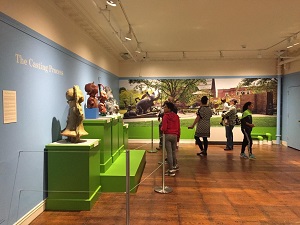 Sal Da Who: The Making of the Sculpture Garden
Sal Da Who: The Making of the Sculpture GardenPhoto: Megan Dowd Lambert
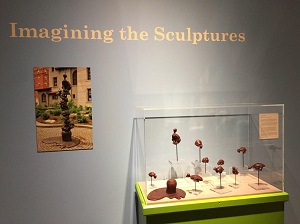 Photo: Megan Dowd Lambert
Photo: Megan Dowd LambertNotably absent from the museum’s biographic and ephemeral displays is any acknowledgement of the troubling racist and xenophobic contents of some of Geisel’s work — particularly in his early political cartoons. Thanks to books like Dr. Seuss Goes to War: World War II Political Cartoons by Theodor Seuss Geisel by Richard Minear, it’s now widely known that he used his platform as a cartoonist to advocate for the internment camps that imprisoned thousands of Japanese Americans during WWII. Additional scholarship has unearthed the racist underpinnings and contents of other work, as well (see, for example, Philip Nel’s forthcoming book from Oxford University Press, Was the Cat in the Hat Black?: The Hidden Racism of Children’s Literature and the Need for Diverse Books). I asked Karen Fisk if and how the museum plans to address this part of Geisel’s legacy, particularly in our current political climate, and she said that they are both listening to concerns and ideas from the public and developing programming and written materials to proactively address issues of diversity and inclusion.
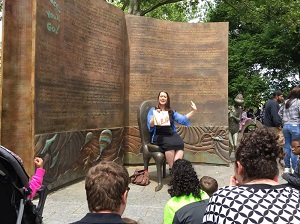 Megan reading Green Eggs and Ham at storytime. Photo: Sean P. Lambert St. Marie
Megan reading Green Eggs and Ham at storytime. Photo: Sean P. Lambert St. MarieA key component in the museum’s educational vision gives me faith that the museum will follow through on this important work: they are publicly committed to presenting all museum materials in both English and Spanish in order to make exhibits and programs accessible and welcoming to the region’s Spanish-speaking population and to send an overt message about the museum’s dedication to inclusivity. I will be interested to see other ways that the museum fosters this sensibility, perhaps with programs addressing themes of diversity and immigration in children’s literature, and maybe by expanding the museum shop’s holdings and the basement level Cat’s Corner craft and activity center’s materials to promote multicultural children’s literature.
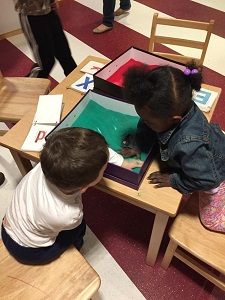 Playing with sensory materials. Photo: Megan Dowd Lambert
Playing with sensory materials. Photo: Megan Dowd Lambert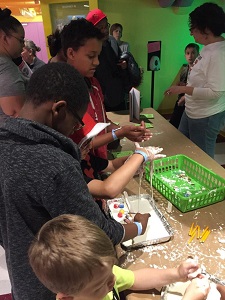 Playing with sensory materials
Playing with sensory materialsPhoto: Megan Dowd Lambert
Such proactive initiatives, among others that the museum is doubtlessly fielding and considering, offer a golden opportunity for them to play a role in making every reader feel at home in the world of children’s books. And that would be…amazing.
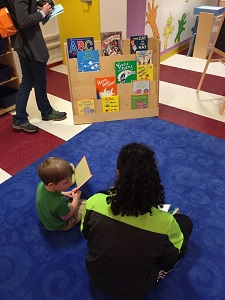 Reading in the Cat’s Corner craft and activity room. Photo: Megan Dowd Lambert
Reading in the Cat’s Corner craft and activity room. Photo: Megan Dowd LambertRELATED
RECOMMENDED
ALREADY A SUBSCRIBER? LOG IN
We are currently offering this content for free. Sign up now to activate your personal profile, where you can save articles for future viewing.







Add Comment :-
Comment Policy:
Comment should not be empty !!!
Megan Dowd Lambert
Hi Emily, I just saw your comment today because I wrote a new blog post that linked back to this piece I wrote for the Horn Book: http://megandowdlambert.com/caring-whole-awful-lot-something-revisiting-amazing-world-dr-seuss-museum/. In it I say that I take issue with the notion that because "the museum is meant for a young audience" it should exclude the xenophobic and racist elements of Seuss's career. After all, which members of this young audience are excluded by such a stance? I agree that the Seuss museum can be a "wonderful resource," and a key point in this piece is that I think it could be even more wonderful and would avoid undermining its success by broadening the scope of its second floor (or perhaps another space if need be) where so much biographical and ephemeral material is displayed. This could include both the materials related to his advocacy of the WWII internment camps that imprisoned thousands of Japanese Americans as well as documentation about how he was, as you say and as Minear's book confirms, an "early and ardent opponent of Nazism, and used his pen to warn against the isolationism of the America First movement." Apart from exhibits, there's much the museum could do in its programs and materials to more fully address Geisel's legacy and to highlight and amplify diverse voices in the field--perhaps particularly those authors and illustrators of color who are making great beginning reader books, like Geisel Honor winner Grace Lin. Or wouldn't it be wonderful to see them offer programs about themes like immigration, the influence of Japanese art on American picture books, diverse beginning reader books, and more? Based on my conversations with museum staff, and their affirmation of the professional development program I led there last week, I'm hopeful the museum will listen to and engage with critics like Mia Wenjen, Philip Nel, and others, in order to benefit from their insights, and I'm eager to see the places they go next.Posted : Sep 03, 2017 08:50
Emily Schneider
The Dr. Seuss museum is a wonderful resource. Other publications have commented on the absence of Dr. Seuss's political cartoons from its collection, although they represent an important aspect of his career, perhaps on the grounds that the museum is meant for a young audience. I don't deny the racism of some of these cartoons, particularly against the Japanese; this is deplorable. But there is a lack of context here. Dr. Seuss, himself from a German-American family background, was an early and ardent opponent of Nazism, and used his pen to warn against the isolationism of the America First movement. The book you mention by Richard Minear gives a complete picture of this courageous stand. It does not only report the racism of the author's attacks on the Japanese, an Axis power, although it does honestly address that issue. Again, there is no excuse, even in the context of the 1930s and 40s, for Dr. Seuss having used racial stereotypes in his warnings about the rise of fascism, nor certainly to have advocated the internment of Japanese Americans. But readers should be aware that he warned against Hitler, criticized the anti-Semitism and xenophobia of Charles Lindbergh, and attacked discrimination against African Americans. Sensitivity to racism and the need for diversity in children's books should not blind us to Dr. Seuss's contributions or to the historical events that frame his career.Posted : Jul 20, 2017 10:33